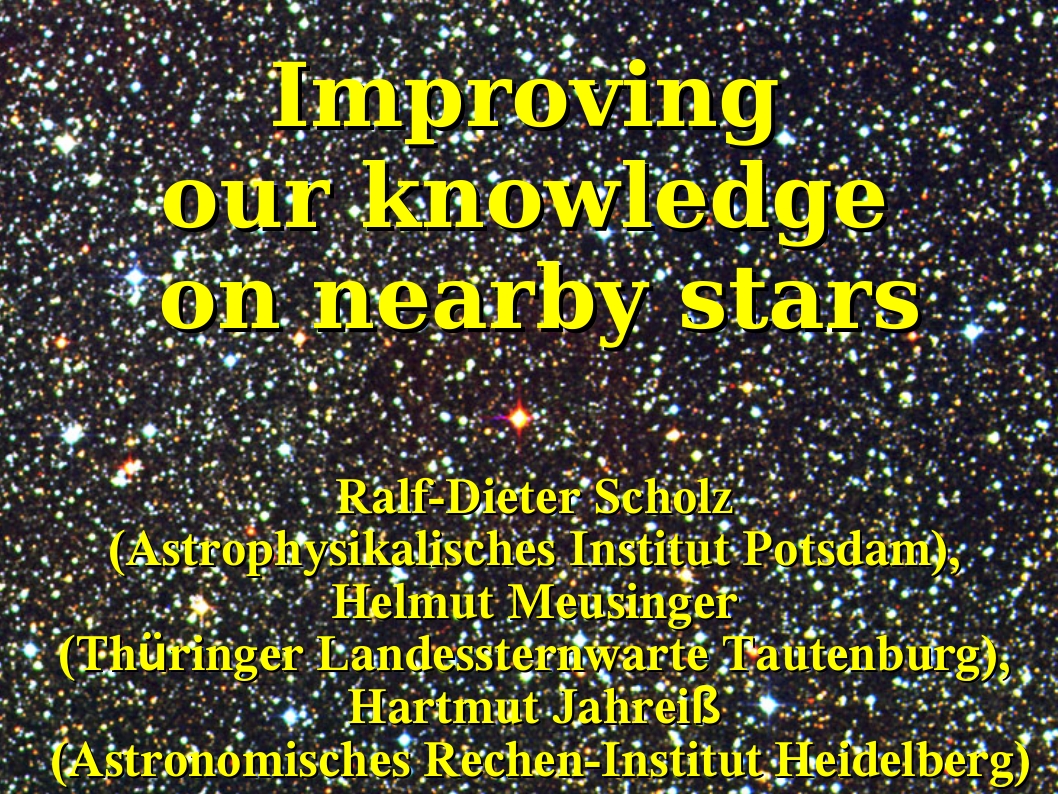

Abstract
The stellar census of the Solar neighbourhood is still remarkably incomplete, and there are many efforts to improve this situation (see e.g. the Palomar/Michigan State University (PMSU) Survey or the Resaearch Consortium on Nearby Stars (RECONS); a nice compilation including links to the series of papers by about ten different groups of authors can be found here).
During the last six years we have carried out classification spectroscopy
for nearby star candidates with the 2.2m telescope of the German-Spanish
Astronomical Centre on Calar Alto. Nearby red dwarf candidates
were selected from the high proper motion catalogues of Luyten
(1979; 1979-1980) which we cross-correlated with the Two Micron All Sky Survey
(2MASS) recently completed (Cutri et al. 2003). Our first discovery, the
classification of LHS 2090 as an M6.5 dwarf at the spectroscopic distance of only
6 pc (Scholz, Meusinger & Jahreiß 2001),
was made in the course of a backup
observing program. Moreover, we found a nearby (d ~ 12 pc) L2 dwarf
which has the same spectral type as the first free-floating brown
dwarf, Kelu 1, but is about one magnitude brighter
(Scholz &
Meusinger 2002). This success encouraged us to continue this search with
dedicated observing campaigns including more than 300 candidates. The results have
recently been presented by
Scholz, Meusinger & Jahreiß (2005). More than 70%
of our targets, most of which turned out to be mid-M dwarfs, lie within the 25 pc
horizon of the catalogue of nearby stars, with 50 objects placed within 15 pc and
8 objects being closer than 10 pc. A large fraction of the
objects in our sample (57%) have meanwhile got independent distance estimates,
mainly by the efforts of Reid and collaborators. Our
distance determinations are generally in good agreement with theirs.
11 rather distant (d > 100 pc) objects have also been identified, including
extremely high-velocity stars which are probably subdwarfs of the Galactic halo
population crossing the Solar neighbourhood.
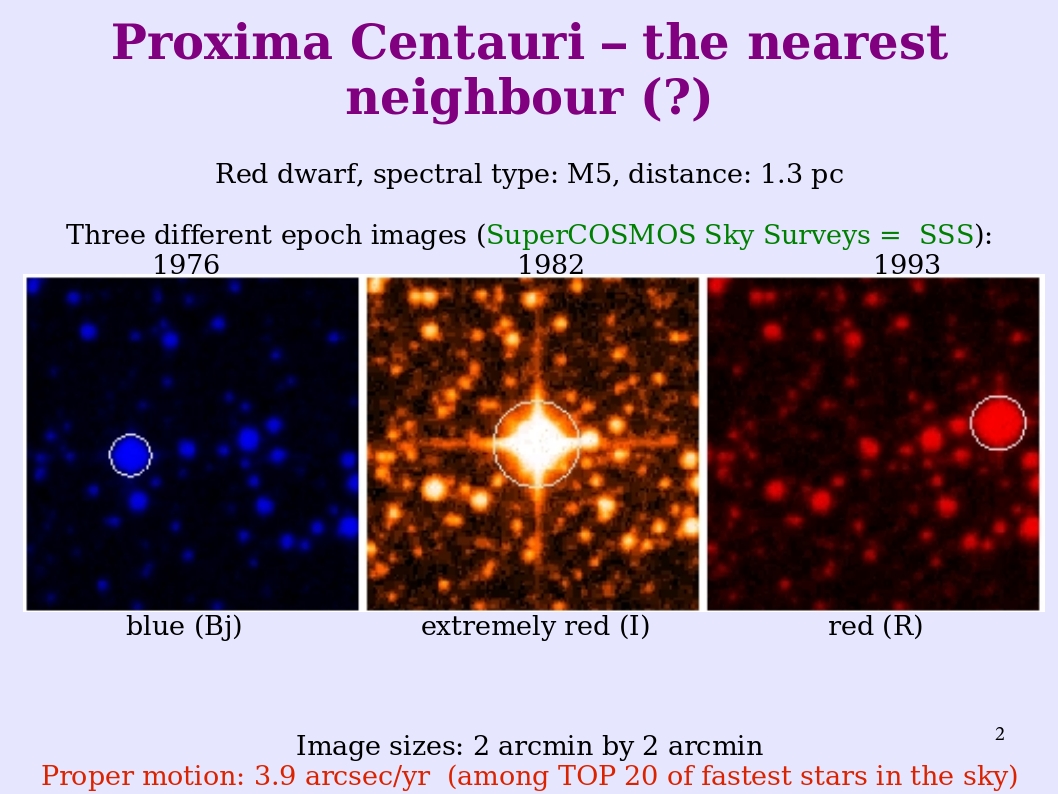
Introduction
Red dwarfs of spectral class M are by far the most numerous stellar species in the Galaxy. However, they are so faint that none of them, even those closest to the Sun are seen to the naked eye (cf. Figure 1, Proxima has an apparent magnitude of V = 11). From the 25 nearest stellar systems only 7 systems including components of earlier spectral classes (A-K) are bright enough (V < 6) to show up on the night sky. A nice 3-D view on the immediate Solar neighbourhood, which allows the reader to get the main properties of each system in a convenient way (by moving the cursor over the field), can be found here.
Deep photographic sky surveys enable us to identify nearby M dwarfs by their proper motion and red colour if multi-epoch and different passband data (Figure 2) are available. A red object with a large proper motion and a relatively faint magnitude is not likely to be a distant red (sub)giant since its tangential velocity would by far exceed the Galactic escape speed. However, high proper motion samples include not only very nearby stars of the Galactic disk population with relatively small velocities with respect to the Sun, but also slightly more distant Galactic halo and thick disk members which do have large heliocentric velocities. More accurate photometry and/or spectroscopy is therefore recommended before time-consuming trigonometric parallax measurements with ground-based telescopes target the preselected nearest candidates. Only one complete magnitude-limited parallax survey has been done so far from space (Hipparcos; ESA 1997). But although this successful mission measured the parallaxes of more than 100000 stars, it did not go deep enough to reach large numbers of M dwarfs.
Whereas all Solar-type stars in the immediate neigbourhood of the Sun (d < 25 pc) are well known and accurately mapped after Hipparcos, our knowledge on the nearest lower-mass dwarf stars (as on white dwarfs too) is by far not complete. Henry et al.(2002) estimated the number of missing stellar systems within 25 pc as high as 63% (Figure 3). Within 10 pc the number of missing systems is still likely about 25% (Reid et al. (2003a) or even more than 30% (Henry et al. 1997, 2002). These estimates are based on the assumptions that we know all neighbouring stellar systems within 5 pc and that their space density is constant up to a distance of 25 pc. But even within 5 pc, there are recent addtions to the stellar census. The RECONS TOP 100 is being regularely updated.

Why care about our neighbours?
What is the motivation getting the nearby stellar sample completed? It has been realised for a long time that the immediate Solar neighbourhood is the only region of a galaxy where there is a real chance for a complete registration of its stellar content. A complete volume-limited stellar sample provides the groundwork for the knowledge of the local stellar luminosity function, the mass function of field stars, and the Galactic star formation history (Reid, Gizis & Hawley 2002; Gizis, Reid & Hawley 2002; Cruz et al. 2003). Moreover, the nearest representatives of a given class of stars can be considered as benchmark sources allowing detailed follow-up studies.
In addition, a new interest in the local stellar population arises from
the field of extra-solar planet research. Planet search programs based
on Doppler spectroscopy first concentrated on the
brighter F, G and K dwarfs. The first planet orbiting an M dwarf
was discovered by Delfosse et al. (1998). More and more late-type dwarfs
are being included in planet search target samples, and
it has been demonstrated that Neptune-mass planets can be found around
M dwarfs (Butler et al. 2004; Bonfils et al. 2005).
Planets around nearby
low-mass dwarfs are good targets for accurate astrometric mass determinations
(Benedict et al. 2002), and
photometric transit searches for planets in habitable zones
are exceptionally sensitive for M dwarfs (Gould et al. 2003).
Finally, nearby, intrinsically faint stars will be prime
targets for the imaging of extrasolar planets by future
space-based missions. Direct imaging is a relatively "target
starved" field. Finding more nearby neighbours is actually very important
in this context.
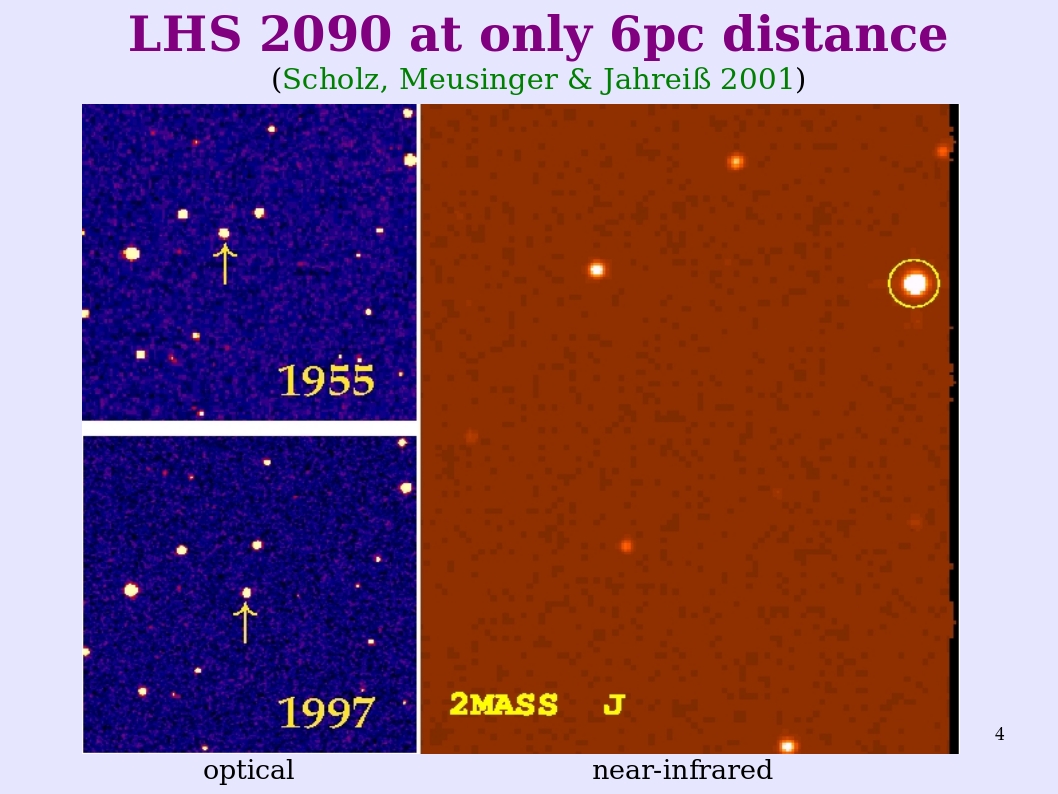
Our first discovery at Calar Alto
In order to find nearby
(d < 25 pc) red dwarfs, we first re-identified high proper motion
stars (µ > 0.18 arcsec/yr) from the NLTT catalogue
(Luyten 1979-1980) in
optical Digitized Sky Survey data for two different epochs and in the
2MASS data base (Figure 4).
Only proper motion stars with large R-Ks colour index
and with relatively bright infrared magnitudes (Ks < 10) were selected
for follow-up spectroscopy. The low-resolution spectrum of LHS 2090
obtained with CAFOS at the 2.2m telescope
and its large proper motion (0.79 arcsec/yr) allowed us
to classify this star as an M6.5 dwarf. The resulting spectroscopic
distance estimate from comparing the infrared JHKs
magnitudes of LHS 2090 with absolute magnitudes of M6.5 dwarfs was
6.0±1.1 pc assuming an uncertainty in absolute magnitude of ±0.4 mag.
Meanwhile, LHS 2090 has got a preliminary trigonometric parallax measurement
of 6.29±0.18 pc (see
the RECONS TOP 100 nearest stars), nicely confirming our original estimate.
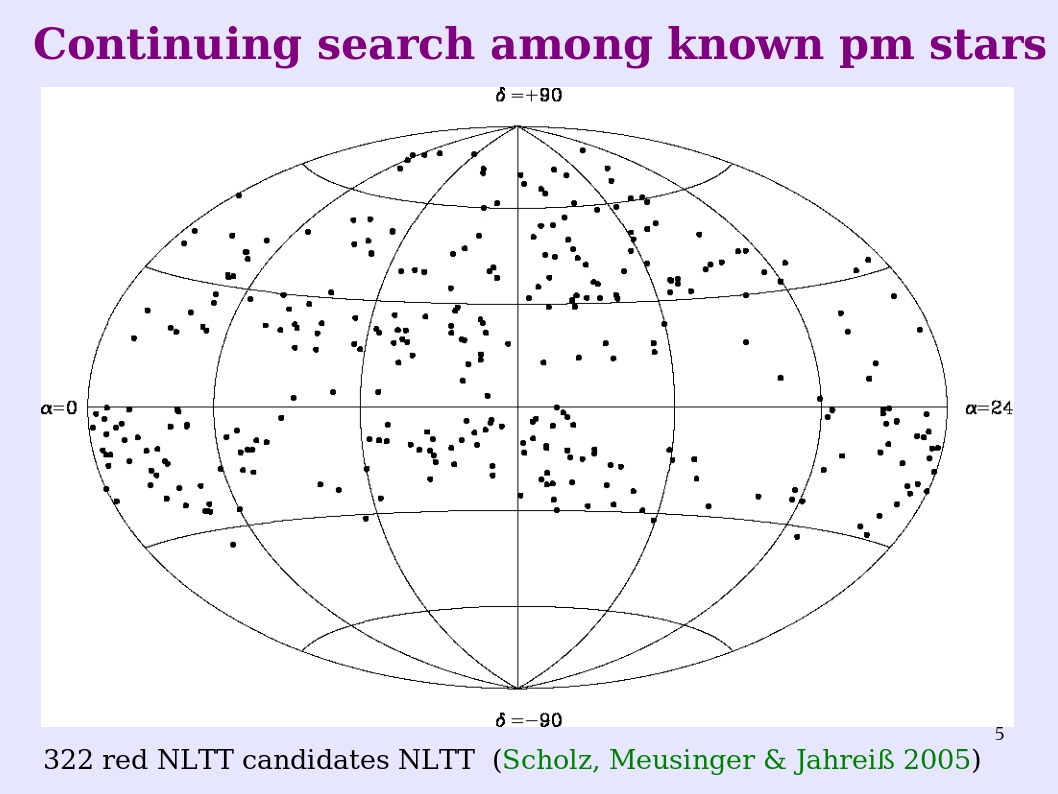
Investigating a larger sample
Most of the stars within the 25 pc horizon of the Catalogue of Nearby Stars (Gliese & Jahreiß 1991), were originally detected as nearby candidates by their large proper motions. The Luyten Half Second (LHS) catalogue includes about 4500 stars with proper motions exceeding 0.5 arcsec/yr (Luyten 1979). The New Luyten Two Tenths (NLTT) catalogue of Luyten (1979-1980) contains about 60000 stars with proper motions larger than 0.18 arcsec/yr. Due to the large numbers of NLTT stars, only small sub-samples of the most remarkable objects with respect to different selection criteria (magnitudes, proper motions, colours) have been further investigated in the literature. Although the LHS stars have gotten more attention, there are still some LHS stars lacking spectroscopic classification. Unfortunately, the original NLTT colours are very crude estimates, and the positions were only given with very low accuracy, which hampered the cross-identification with other catalogues providing better photometry.
Special efforts were therefore needed in order to re-identify NLTT stars
and to select nearby candidates based on better colour measurements.
A large sample of 322 NLTT stars observable from Calar Alto
(Figure 5)
was constructed (for details
see Scholz, Meusinger & Jahreiß (2005)).
90% of these stars were selected based on
preliminary photometric distance estimates using improved optical
photometry (photographic R magnitudes and V magnitudes)
from various other catalogues combined with the accurate near-infrared
2MASS photometry. The remaining 10% were proper motion stars from the NLTT
or LHS catalogues which were poorly investigated or just lacking spectral
types.

Optical spectroscopic data (a representative set of spectra is shown in Figure 6) were collected over a period of five years. With only a few exceptions, all objects from our sample were observed with the 2.2m telescope of the German-Spanish Astronomical Centre on Calar Alto. The focal reducer and faint object spectrograph CAFOS was used with the grism B400 giving a wide wavelength coverage from about 3600 Å to 8500 Å and a dispersion of 10 Å per pixel on the SITe1d CCD. With a width of the entrance slit of typically between 1 and 2 arcsec (dependent on the seeing conditions), the effective resolution is about 20 to 30 Å FWHM. The vast majority of our objects were observed during two dedicated observing runs with (a) 10 nights in March 2002 (visitor mode) and (b) 6 nights in August/September 2002 (service A mode). For the other targets spectra were taken in the frame of backup programs for 10 different observing runs with CAFOS during the period from 1999 to 2004.
A large number of comparison stars of known spectral types, mainly taken
from the
NStars and
ARICNS data bases for nearby stars were observed
during the nights of our target observations.
As expected, these template spectra formed a sequence sorted by
spectral type. The only exception was the star
Gl 273 planned to be used as M3.5 standard. It had
quite a peculiar spectrum, resembling an M2.5 star in the blue part
but exhibiting a much too red continuum in the red.
The template spectra served as the basis for our spectral classification.
After normalisation at 7500 Å absolute values of the
differences between the flux densities of the target and the template
were computed. For every comparison with a template the mean value
and the median were computed. The spectral type of a target was
subsequently identified with the spectral type of those templates where
a minimum of the mean and median absolute differences was reached.
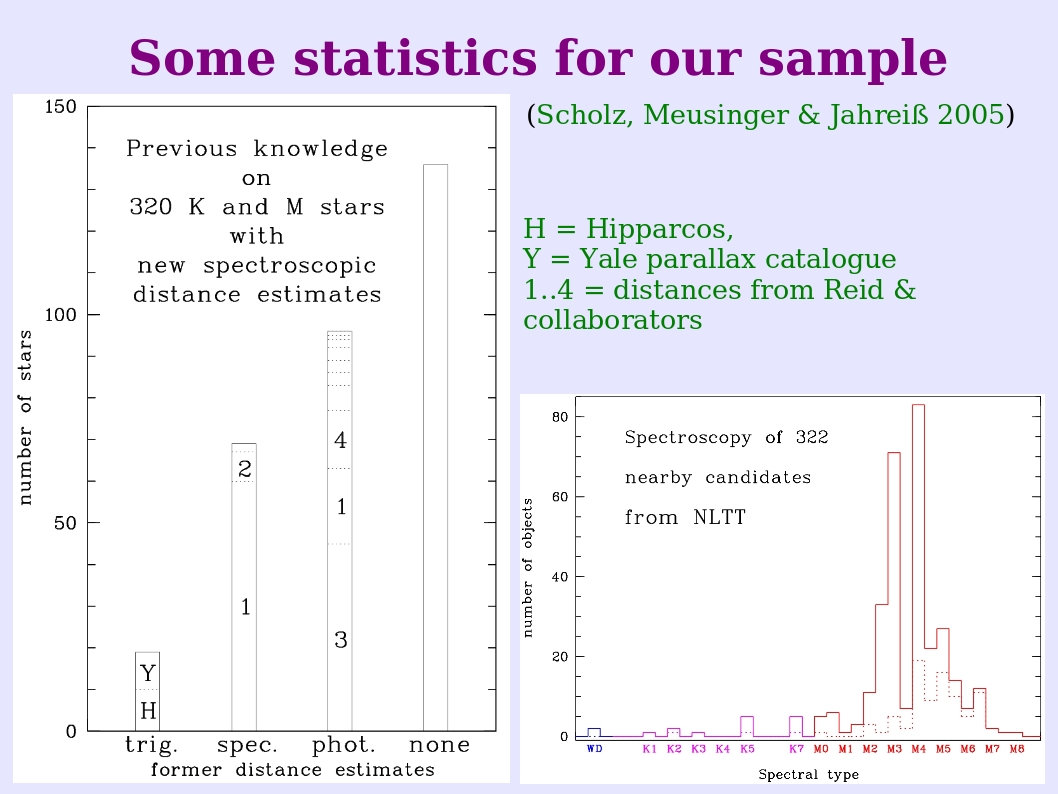
Since the M3.5 standard turned out to be not useful as a
template (see above) the histogram of the
spectral types which we derived for our targets
(Figure 7, Right)
shows an apparent deep minimum for M3.5 stars. We assume
that ~30% of our M3 and M4 dwarfs could be in fact M3.5 dwarfs.

The histogram on the left part of Figure 7 shows how many stars in our sample had previous distance estimates. Only about 20 objects had measured trigonometric parallaxes. All but 4 of these objects were previously lacking spectral types. The relatively low resolution of our spectroscopy combined with the direct comparison of the full spectra with templates provides a classification nearly as accurate as achieved by others using slightly higher resolution classification spectroscopy in the same system (see Figure 8, Left). Compared to other previous classifications (Figure 8, Right), often not corresponding to the presently adopted system, our spectral types should be prefered.
We determined spectroscopic distances on the basis of a new calibration of absolute J magnitudes using all K, M and L dwarfs in the forthcoming CNS4 (Jahreiß, in preparation) with trigonometric parallaxes better than 20% (details are given in Scholz, Meusinger & Jahreiß (2005)). The dispersion is generally of the order of 0.4-0.5 mag. This transforms to errors of ~20% for our spectroscopic distances.
Galactic halo stars in a proper motion sample
The spectral resolution we used with CAFOS (Figure 6)
is not high enough for computing
reliable TiO and CaH indices (Reid, Hawley & Gizis 1995) of our
targets. Therefore, we cannot distinguish between normal K and M dwarfs
and subdwarfs using these indices according to the classification scheme
for subdwarfs developed by Gizis (1997). We did, however, expect some
subdwarfs with halo kinematics in our sample including about 10% of
objects selected only on the basis of their high proper motion. Even
though halo stars are relatively rare when compared to the number density
of Galactic disk stars, they are over-represented
in high proper motion samples.

We have used the mean absolute magnitudes of normal K and M dwarfs with trigonometric parallax measurements for the spectroscopic distances of all objects in our sample. By doing so, we overestimate the distances of those objects, which are in fact subdwarfs. The comparison of the spectroscopic distances of some of our objects with previous determinations from ground-based trigonometric parallax measurements revealed some discrepancies. Figure 9 shows the spectroscopic distance estimates and the resulting tangential velocities of all 322 objects in our sample. Among the stars with trigonometric parallaxes in our sample, LHS 299 has the largest tangential velocity of about 440 km/s. Despite this previously known large velocity, there are no hints in the literature on the subdwarf nature of this object. Our distance estimate based on the assumed classification of LHS 299 as a normal M0 dwarf is nearly twice as large as its trigonometric distance. This discrepancy can only be explained, if this object is in fact a subdwarf.
We expect that the distances to at least four other suspected subdwarfs may be only about half of our original estimates (indicated by the dotted lines and open circles in Figure 9). Our original spectral classification of these four objects (LP 552-21, LP 323-168, LHS 5343, LHS 6147) ranges between K2 and M0.5, and for a first guess we can assume similar subdwarf subtypes. There are four sdK7, three sdM0.0 and three sdM0.5 stars with ground-based trigonometric parallaxes listed in Gizis (1997). Using for some of these objects the Hipparcos (ESA 1997) parallaxes instead of the ground-based ones, we compute mean absolute J magnitudes of 6.9, 7.5 and 7.8 for sdK7, sdM0.0 and sdM0.5, respectively. Compared to the absolute magnitudes of normal K7, M0.0 and M0.5 dwarfs, these values are 1.3 to 1.6 mag fainter, corresponding to a factor of 0.55 to 0.48 in the computed distances, and thus reduce their tangential velocities by half.
Altogether, there are 11 objects with initial tangential velocities between 250 and 1200 km/s which we suspect to be subdwarfs. If so, their reduced velocities would be still very large.
What about sub-stellar neighbours?
Brown dwarfs are failed stars which did not reach the critical mass of stars during their formation. With surface temperatures typically even lower than those of red dwarf stars the colours of these sub-stellar objects are even redder. New near-infrared sky surveys like the 2MASS and the DEep Near-Infrared Survey (DENIS) and deep multi-colour optical surveys like the Sloan Digital Sky Survey (SDSS) uncovered large numbers of objects cooler than the latest-type M dwarfs. New spectral classes, L and T, describing these ultracool objects, were defined only recently (Kirkpatrick et al. 1999, Burgasser et al. 2002). About 50% of the L dwarfs and all T dwarfs in the Solar neigbourhood are brown dwarfs, whereas among late-M dwarfs only a few are sub-stellar objects (Kirkpatrick 2005).
The majority of more than 450 L and T dwarfs known (see the DwarfArchives) were found as a result of colour-based searches, mainly using 2MASS and SDSS. However, some of the nearest objects like the first isolated L dwarf Kelu 1 (Ruiz, Leggett & Allard 1997) have been discovered by new deeper high proper motion surveys extending Lyuten's catalogues to fainter magnitude limits. The only known brown dwarf among the NLTT stars is LP 944-20 with an M9.5 spectral type. Although more and more faint red NLTT stars have been investigated with spectroscopic follow-up for the last years, no other brown dwarfs were found among them.
Using the SuperCOSMOS Sky Surveys (SSS) data as basis for a new high proper motion survey, one of the first relatively bright but very red candidates (I = 16, R-I = 2.8, Bj-R = 3.6) was detected in the equatorial zone by its large proper motion of 0.56 arcsec/yr. Spectroscopic follow-up observations with the 2.2m telescope of the Calar Alto Observatory classified this object, SSSPM J0829-1309, as L2 dwarf very similar to the first free-floating L dwarf Kelu 1 (Figure 10). Assuming SSSPM J0829-1309 to have the same luminosity as Kelu 1, the distance of the new L dwarf was estimated as about 12 pc since it is about one magnitude brighter than Kelu 1 in the SSS I and R bands. This makes SSSPM J0829-1309 one of the nearest objects of its class (Scholz & Meusinger 2002).
Among all 476 currently known L and T dwarfs only 103 have a
proper motion measurement, and only 72 have a measured trigonometric
parallax with only 10 of these being located within 10 pc (according to the
DwarfArchives as of Nov. 28, 2005).
There is a lack of L dwarf neighbours (the six nearest
L/T dwarfs to the Sun are all T dwarfs), which is expected if one
considers that most of the brown dwarfs have had enough
time to cool to later types (Burgasser 2004). Proper
motion surveys will continue to play an important role in
completing the brown dwarf census of the immediate Solar neighbourhood.
This was demonstrated by the discovery of the nearest brown dwarf
epsilon Indi B (Scholz et al. 2003, see also
ESO press release), later resolved as a close binary
system of two T dwarfs (McCaughrean et al. 2004).
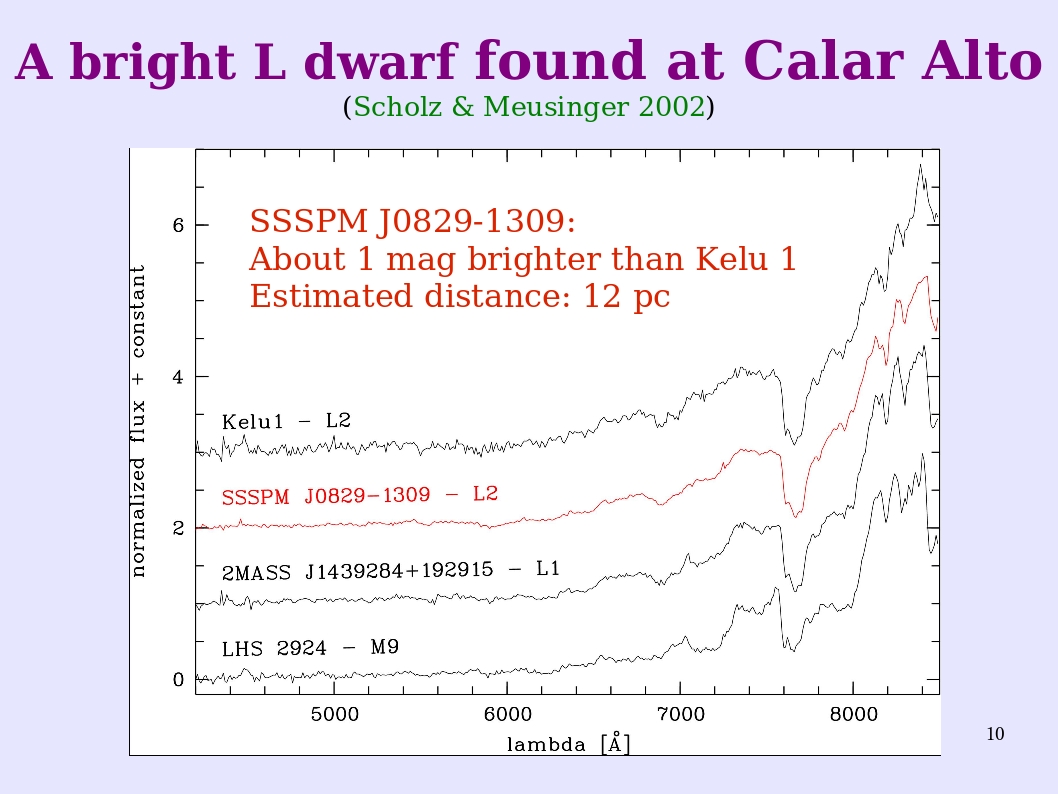
Conclusions
About 85% of our M and K stars are found to lie within 30 pc, and 72% are within 25 pc. This is a high success rate, if we take into account that about one third of the objects beyond 30 pc were selected for other reasons than for their optical-to-infrared colours and corresponding preliminary photometric distance estimates. We conclude that a purely photometric selection based on all available photographic optical magnitudes combined with the meanwhile completed 2MASS data base may be worth doing.
Since about 10% of the objects in our sample were selected only based on their high proper motion, we expected to find rare high-velocity objects which are representatives of the Galactic halo crossing the Solar neighbourhood. In fact, we found more than about 10 objects with extremely large tangential velocities which we suspect to be subdwarfs.
Among the nearest objects found, there are eight stars with distances smaller than 10 pc. For five of them, spectroscopic distances were obtained for the first time. There are eight objects without any independent distance estimates that we found to be within 15 pc. Out of all 322 objects in our sample, 138 did not have any other distance determination.
With few exceptions, mainly concerning suspected subdwarfs, our distance estimates agree well with values determined by other groups. The brightest object in our proper motion sample which got the earliest spectral type (K1 according to our classification) is in fact a high-velocity giant. Two other bright (J < 7) objects are possible (sub)giants. All other objects are clearly dwarfs.
Compared to the expected large numbers of missing stellar systems within the 25 pc horizon (see Figure 3) our study has investigated and uncovered only a small fraction of the unknown close neighbours to the Sun. Clearly, further efforts are needed to complete the 25 pc sample.
The majority (more than 90% ?) of our sub-stellar neighbours (not included in the estimates of missing systems shown in Figure 3) are certainly still lurking in the dark. If the predictions are correct that there may be as many brown dwarfs as stars we should not be surprised if a brown dwarf closer to the Sun than Proxima will be found.
Acknowledgements
We would like to thank the Calar Alto staff for their kind support and for their help with the observations, in particular for the part carried out in service mode.
We acknowledge the use of images from the Digitized Sky Survey, produced at the Space Telescope Science Institute under U.S. Government grant NAG W-2166. The images of these surveys are based on photographic data obtained using the Oschin Schmidt Telescope on Palomar Mountain and the UK Schmidt Telescope. We would also like to acknowledge the use of the batch interface to DSS available at the Astronomical Data Analysis Center of the National Astronomical Observatory of Japan. This research has made use of data products from the SuperCOSMOS Sky Surveys at the Wide-Field Astronomy Unit of the Institute for Astronomy, University of Edinburgh. We have also used (via the Gator query building service) data products from the Two Micron All Sky Survey, which is a joint project of the University of Massachusetts and the Infrared Processing and Analysis Center/California Institute of Technology, funded by the National Aeronautics and Space Administration and the National Science Foundation. We acknowledge the use of the Simbad data base and the VizieR Catalogue Service operated at the CDS.
References